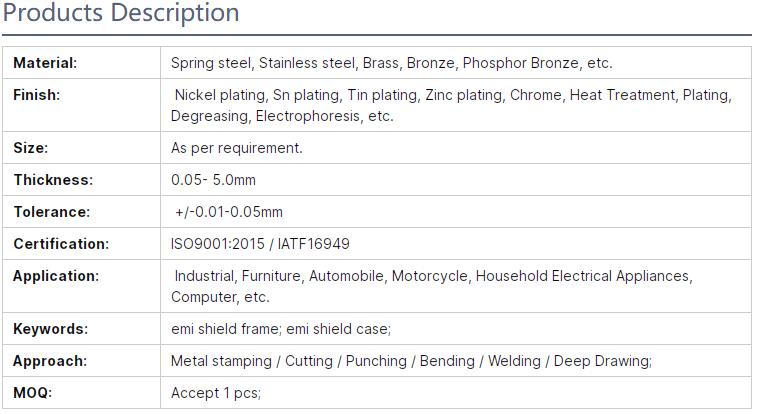Material: Stainless steel, phosphor bronze, tinplate (material can be specified)
Specification: Customized based on drawings/samples provided
Environmental standards: ROHS/REACH standards
Sampling time: 2-5 days (can be expedited)
Production cycle: 3-10 days (can be expedited)
Mold maker: Teacher Fu with over 20 years of experience in mold making
Customized phone number: +86-13682517935
EMI Shield is crucial in preventing electromagnetic interference (EMI). Our EMI Shielding solutions provide high-performance shielding for PCB, medical devices, and industrial applications.



An EMI Shield (Electromagnetic Interference Shield) is a material or structure used to prevent electronic devices from being affected by external electromagnetic interference (EMI). It is typically made of conductive metal or special coatings and is widely used in PCBs (Printed Circuit Boards), 5G communications, automotive electronics, medical devices, and more to ensure the stable operation of electronic components.
EMI shielding works through reflection and absorption to reduce electromagnetic interference:
Reflection: The shielding material reflects external electromagnetic waves, preventing them from entering the device.
Absorption: Some EMI shielding materials absorb electromagnetic wave energy and convert it into heat, thereby reducing interference.
EMI shielding is widely used in the following fields:
Consumer Electronics: Smartphones, laptops, smart home devices
Automotive Electronics: ADAS (Advanced Driver Assistance Systems), Battery Management Systems (BMS)
Communication Equipment: 5G base stations, Wi-Fi routers, satellite communication systems
Medical Devices: Pacemakers, MRI scanners, ultrasound machines
Aerospace: Flight control systems, radar equipment
Industrial Control: Automation equipment, power systems
EMI shielding comes in various forms based on materials and applications:
EMI Shielding Can: Used for PCB components, typically made of stamped metal.
EMI Shielding Foam: Flexible shielding solution for irregularly shaped devices.
EMI Shielding Gasket: Used for enclosures and cable interfaces, ensuring good conductivity and sealing.
EMI Shielding Coating: Can be sprayed on plastic housings or circuit boards for enhanced shielding.
Conductive Tape: Used for repairs or temporary shielding of EMI sources.
When selecting EMI shielding, consider the following factors:
Shielding Effectiveness (Measured in dB): Different applications require varying shielding levels, typically ranging from 30dB to 100dB.
Material: Copper, aluminum, stainless steel, nickel-plated fabric, etc.
Thickness: Thicker shielding materials often provide better performance.
Conductivity: Some applications require highly conductive materials to reduce contact resistance.
Installation Method: Options include soldering, snap-fit, adhesive, or screw fastening.
EMI Shield (Electromagnetic Interference Shielding) and RFI Shield (Radio Frequency Interference Shielding) are both used to protect electronic devices from interference. The key differences are:
EMI refers to all types of electromagnetic interference, including static electricity, lightning, and electromagnetic waves.
RFI specifically refers to radio frequency interference (typically within 10kHz - 100GHz) that affects wireless communication devices.
EMI Shields are used in a broader range of applications, while RFI Shields are mainly for wireless communication devices (such as Wi-Fi, Bluetooth, RFID systems, etc.).
You can test EMI shielding effectiveness using the following methods:
EMI Test Equipment: Measures how well the shielding material attenuates electromagnetic waves (measured in dB).
Anechoic Chamber Testing: Conduct tests in an interference-free environment to evaluate shielding performance.
Oscilloscope & Spectrum Analyzer: Detects electromagnetic noise signals to assess shielding performance.
The installation method depends on the specific application:
Soldered Installation (Common for PCB shielding cans)
Adhesive Shielding Materials (e.g., conductive tapes, conductive foams)
Screw Fastening (Used for shielding enclosures and cabinets)
Snap-Fit Shielding Cans (Removable design for easy maintenance)
Yes, most EMI shielding materials comply with international environmental standards:
RoHS (Restriction of Hazardous Substances Directive): Ensures that the materials do not contain harmful substances like lead, cadmium, and mercury.
REACH (Registration, Evaluation, Authorization, and Restriction of Chemicals): Complies with EU chemical regulations.
UL Certification (Underwriters Laboratories): Some EMI shielding materials meet fire safety standards.
When choosing EMI shielding, check the supplier’s compliance certificates to ensure adherence to industry and environmental standards.
✅ High Shielding Performance: Provides 30dB-100dB shielding effectiveness, reducing electromagnetic interference.
✅ Multiple Material Options: Available in stainless steel, copper, aluminum, conductive fabric, conductive foam, and more.
✅ Custom Solutions: Supports OEM/ODM customization for different sizes and installation methods.
✅ Certified for Safety & Compliance: RoHS, REACH, and UL certified for environmental and safety requirements.
✅ Wide Applications: Suitable for 5G communication, automotive electronics, PCB protection, industrial control, and more.
Yes, we offer professional technical support, including:
EMI Shield Selection Advice
Custom Product Development
EMC Testing & Optimization Solutions
Bulk Production Support
If you need assistance, feel free to contact our engineering team for expert recommendations!
Contact: Mark Yu
Phone: +86-13682517935
E-mail: mark@szydct.com
Whatsapp:+86-13682517935
Add: 7th Floor, No. 128, Shangnan East Road, Huangpu Community Xinqiao Street, Baoan District,Shenzhen Chian
We chat
